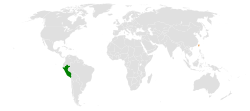 | |
Peru |
Taiwan |
|---|---|
| Diplomatic mission | |
| Commercial Office of Peru to Taipei | Taipei Economic and Cultural Office in Peru |
Peru–Taiwan relations are the bilateral relations between the Republic of China (Taiwan) and the Republic of Peru. Relations were officially severed in 1971, but are unofficially maintained through the presence of representative offices in each country's capital city.
History
Peru established relations with the Qing dynasty with the signing of a treaty in Tianjin on June 26, 1874.[1][2] Peru's first Resident Ambassador was named the next year, assuming his duties on May 20, 1878, while the Chinese ambassador would only reach Peru in 1883, after the War of the Pacific.[1][3][4] Relations between both states started with the Coolie Trade and matured during the ‘Hundred Years weakness and poverty’ (Wang, 1993) from the 1840s to 1949 of the impoverished Qing China, followed by a republic divided by civil wars and invaded by Japan.[5]
After the establishment of the Republic of China, Peru maintained its relations with the new Kuomintang government. In 1944, the diplomatic status of the two countries was raised to embassy level, and high-level officials of the two countries exchanged frequent visits in the 1950s and 1960s.[6] As a result of the Chinese Civil War, Peru closed its embassy in Beijing in 1946.[7]
The anticipated official announcement of Peru's recognition of the People's Republic of China instead of the Republic of China was issued via a memo made public on November 2, 1971. In response, the final Kuomintang ambassador, Liu Tsung-han, left for Jorge Chávez International Airport on November 4, making a speech before departing to a crowd of several pro-Kuomintang Chinese denouncing the memo and announcing the cessation of diplomatic relations between both countries on the same day.[8]
Following Tsung-han's departure, other members of the diplomatic staff also left for Taiwan. On December 14, the Kuomintang's emblem was removed from the embassy,[8] then located on the 5th floor of Jr. Pablo Bermúdez 177,[9] and a group composed of Consul General Ding Zhan'ao and secretaries Cai Shuiliang and Wu Jixiong left for Taiwan on January 1, 1972. On the same day, Chinese associations in Lima celebrated the founding of the Republic of China, then still popular among the Chinese colony in Lima.[8]
The new embassy of the Beijing government would later open in February 1972.[10] Since the establishment of relations with the People's Republic of China, the Republic of China is generally referred to as "China Taipei" or simply "Taiwan", with names such as "Nationalist China" having fallen out of use.
High-level visits
High-level visits from the Republic of China to Peru
- Special Representative Lien Chan (2008)[11][12]
- Special Representative James Soong (2016)[13]
High-level visits from Peru to the Republic of China
- President Manuel Prado Ugarteche (1961)
- Prime Minister Ernesto Montagne Sánchez (1970)[14]
- Former president Alejandro Toledo (2008)[15]
- Congressman Luis Galarreta (2019)[16]
Trade
As of 2022, Peru is Taiwan's fifth commercial partner in Latin America.[17]
Resident diplomatic missions
- Taiwan has a representative office in Lima.
- Peru has a representative office in Taipei.
-
ROC office in Lima during National Day celebrations
-
Peruvian office in Taipei, located in the building to the right
See also
- Foreign relations of Peru
- Foreign relations of Taiwan
- List of ambassadors of the Republic of China to Peru
- List of ambassadors of Peru to the Republic of China
References
- ^ a b Chong Geng, Andrés Humberto (April 2003). "Breve historia de las relaciones sino-peruanas". China Today.
- ^ "La inmigración china en el Perú (1850-1890)". Boletín de la Sociedad Peruana de Medicina Interna. 5 (3). 1992.
- ^ Basadre Grohmann 2014, p. 357.
- ^ García Corrochano 2019, p. 61.
- ^ Park, Jae (2013). "Cultural artefact, ideology export or soft power? Confucius Institute in Peru". International Studies in Sociology of Education. 23: 1–16. doi:10.1080/09620214.2013.770205. S2CID 143873899.
- ^ "駐處與駐地關係" [Residency and Resident Relations [between the Republic of China and Peru]]. Portal of Republic of China (Taiwan) Diplomatic Missions.
- ^ García Corrochano 2019, p. 64.
- ^ a b c Zhang 2022, p. 4.
- ^ 國立政治大學校友通訊錄 (in Chinese). 國立政治大學校友會. 1964. p. 15.
- ^ Wolfgang Bartke (1981). "The diplomatic service of the People's Republic of China as of June 1981". news.xinhuanet.com. Instituts für Asienkunde. p. 110. Archived from the original on October 17, 2015. Retrieved 2017-04-23.
- ^ "Arribó a Lima líder de economía de China Taipei". Andina. 2008-11-20.
- ^ "Cumbre de Lima ha sido una de las mejores en la historia de APEC, afirma líder de China Taipei". Andina. 2008-11-23.
- ^ Stacy Hsu (6 October 2016). "Soong to represent president at APEC leaders' summit". Taipei Times.
- ^ "秘魯總理訪華". 典藏台灣. 2008-06-28.
- ^ "Visita de ex presidente peruano". Noticias de Taiwan. 2008-07-16.
- ^ "Presidente de la Comisión de Relaciones Exteriores del Congreso del Perú recibe honores en Taiwan". Noticias de Taiwan. 2019-05-29.
- ^ Vásquez, Laura (2022-10-20). "Perú se ha convertido en el quinto mayor socio comercial de Taiwán en Latam". La Cámara.
Bibliography
- Basadre Grohmann, Jorge (2014). Historia de la República del Perú [1822-1933]. Vol. 5. El Comercio. ISBN 978-612-306-353-5.
- Zhang, Xiaoxu (2022-09-19). "La identidad política de los inmigrantes chinos en el Perú con su país de origen: a principios de la década 1970s". Ibero-América Studies. 4 (2): 30–38. doi:10.55704/ias.v4i2.04. S2CID 252402046.
- Clemente Pecho, Jazmina Lizbeth (2020). La importancia de la rectoría del Ministerio de Relaciones Exteriores del Perú en la celebración de instrumentos internacionales: análisis de la celebración de instrumentos con entidades no estatales en el marco de las relaciones del Perú con China y Taiwán (PDF) (in Spanish). Lima: Academia Diplomática del Perú Javier Pérez de Cuéllar. p. 84.
- García Corrochano, Luis (2019). Las relaciones entre Perú y China en perspectiva histórica (PDF) (in Spanish). Lima: PUCP. ISBN 9781909890459.
{{cite book}}:|work=ignored (help)



